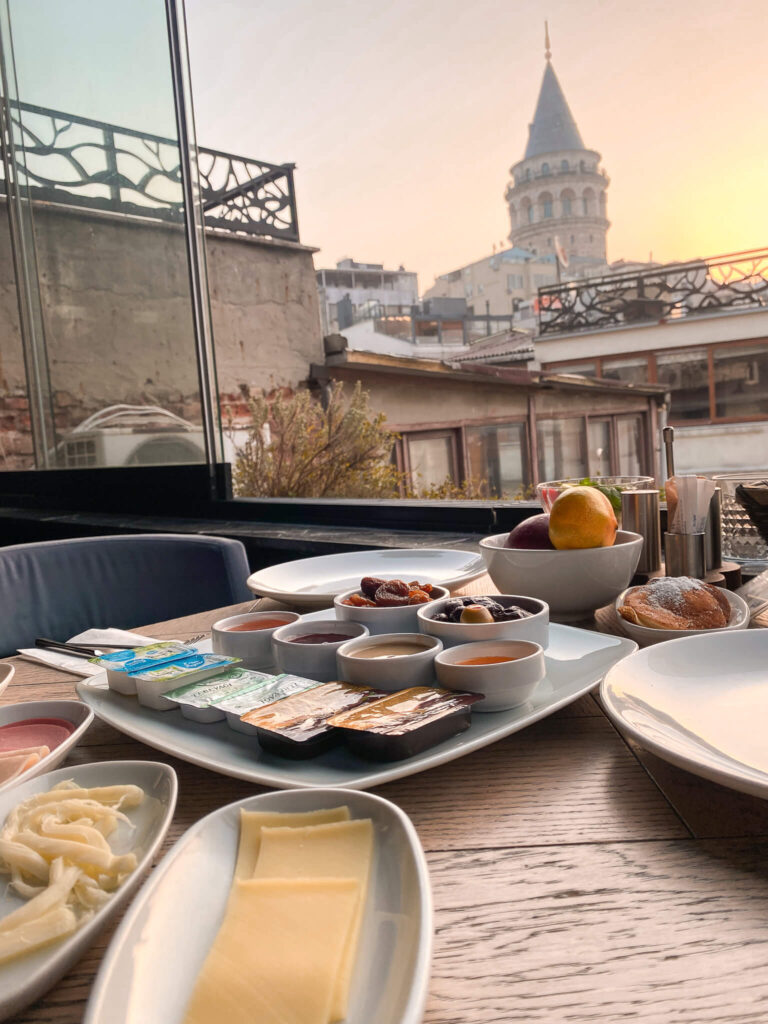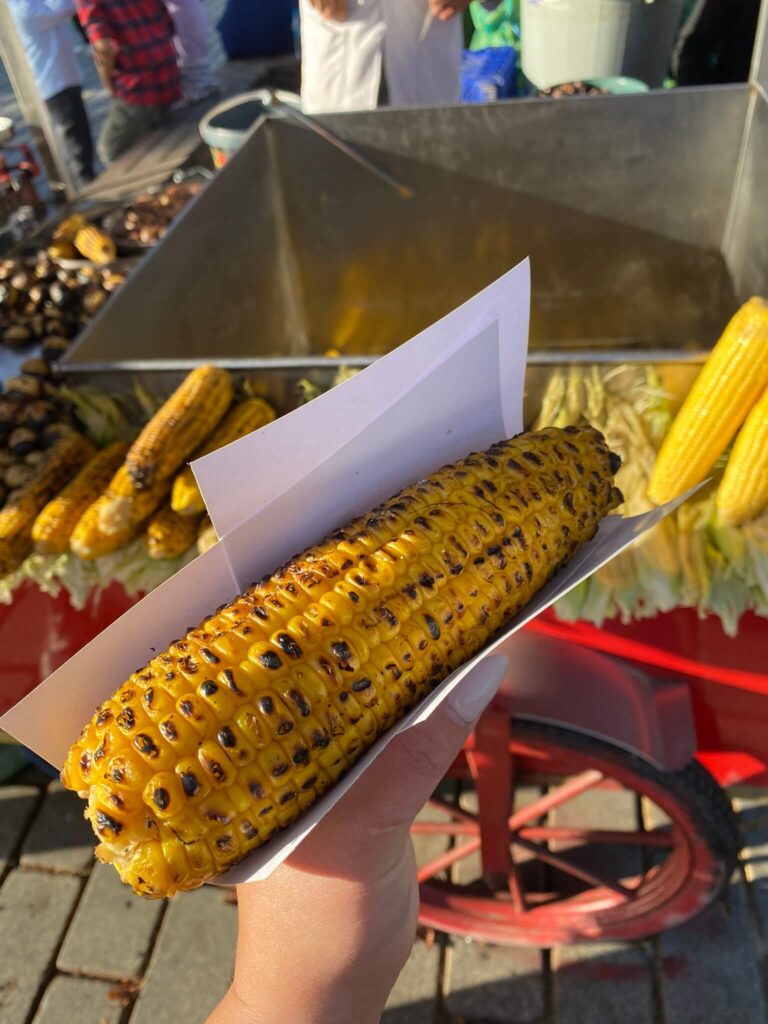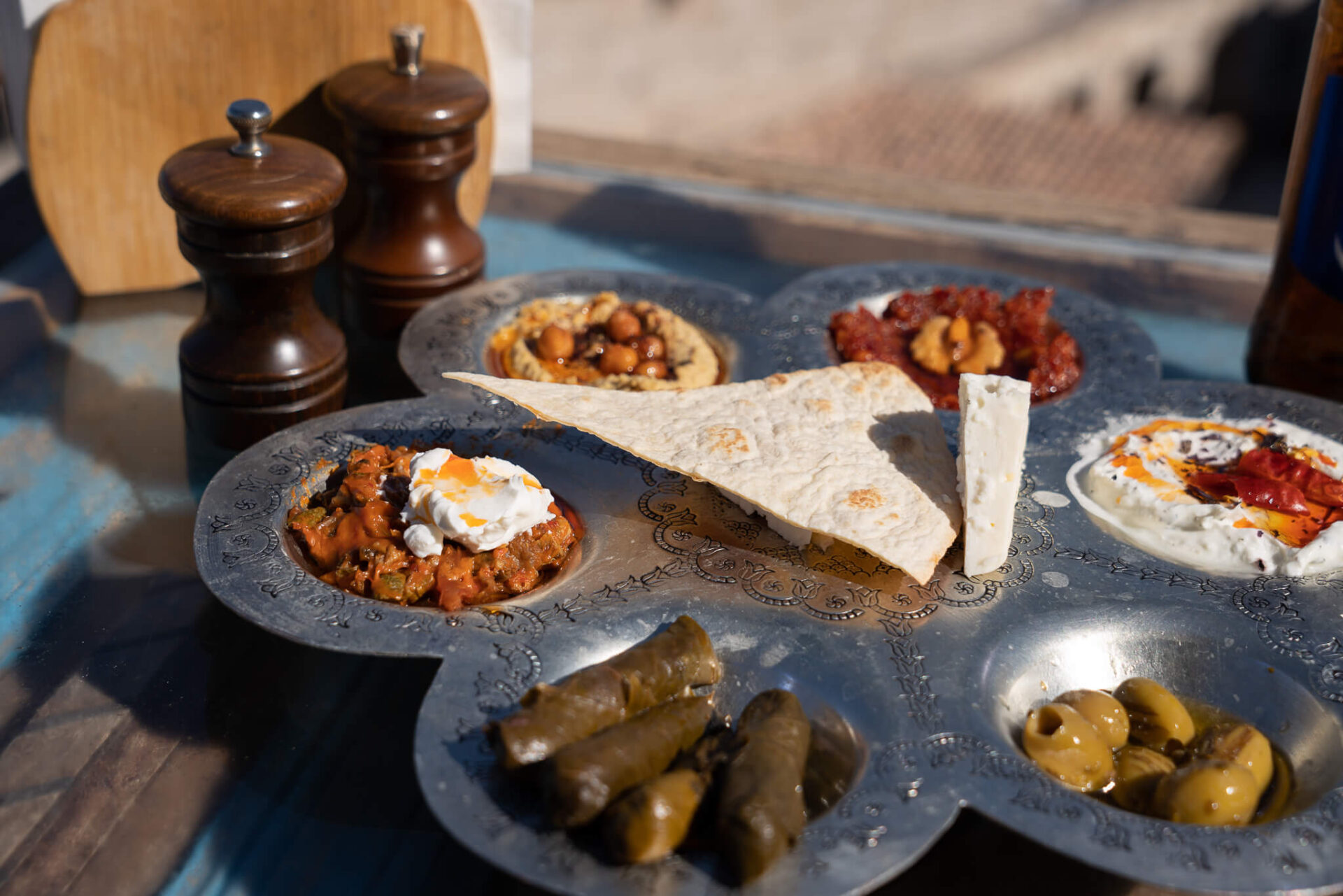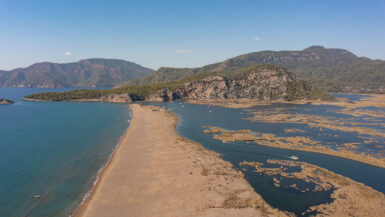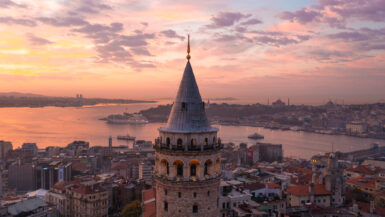Turkey is a gastronomic paradise, we’re not joking! We returned from there with a few extra kilos of “baggage” and we don’t regret anything, absolutely nothing! So what and where to eat in Turkey? Welcome to our Turkey food guide!
We don’t know why we imagined Turkish cuisine as extremely heavy and meaty. Meat is indeed quite popular, but usually in grilled form, and served with plenty of vegetables and carbohydrates such as bread or rice. Turkish cuisine is rich in vegetables, including vegetable stews, and it seems like a great choice for vegetarians or even vegans. Turkish cuisine also uses many interesting spices that enhance the taste of fresh and delicious ingredients even more!
Turkey is a huge country and its cuisine varies by region. In the Aegean Sea area, it is rather a light and fresh Mediterranean cuisine that shares many common features with Greek cuisine. In addition to regional differences, each city may have its own specialty that cannot be found anywhere else, and Istanbul is, in our opinion, the real kingdom of street food.
As you can imagine, writing such a guide from two weeks of traveling to different parts of Turkey is a challenge. Therefore, we will divide the guide into two parts – what and where to eat, and then we will highlight each place we visited. There will also be a place for Turkish cuisine in general and dishes that we encountered practically everywhere we went.
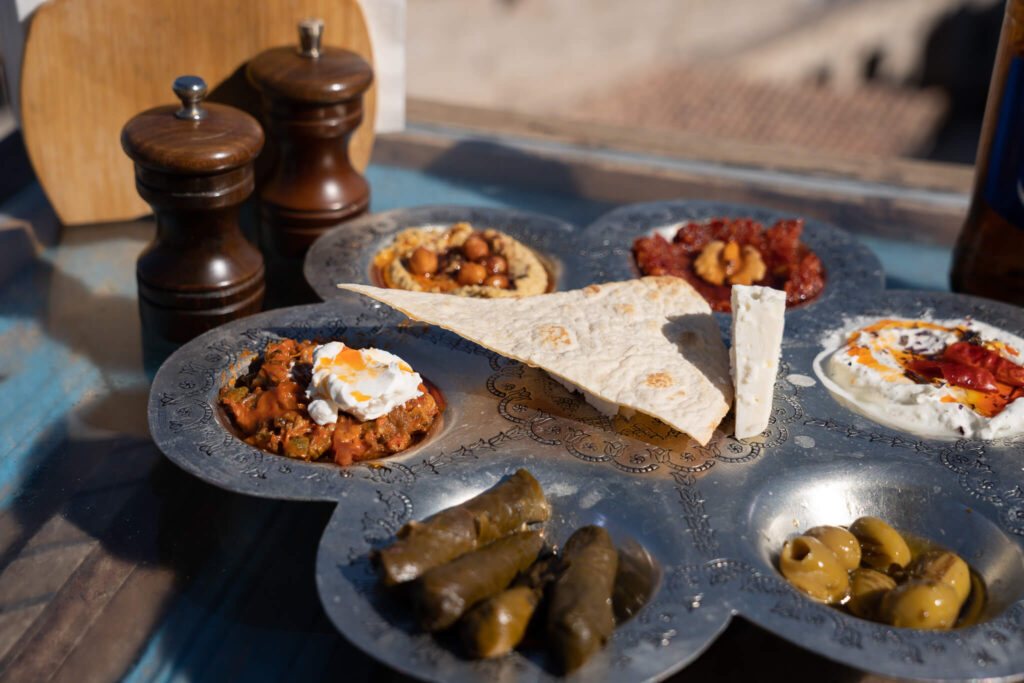
What to eat in Turkey?
Turkish cuisine in general – Turkey food guide
Kebab – Turkey food guide
A trip to Turkey without eating kebab (or rather kebap, but in fact, the spelling is not a big mistake, because kebab is eaten in many Middle Eastern countries and the spelling varies slightly depending on the country) just doesn’t count! Kebab is simply roasted meat, although the most famous for us Europeans is, of course, doner kebab.
Doner kebab is meat threaded on a spit and roasted vertically, from which slices of meat are cut off. Doner usually comes in two versions – chicken and lamb, but you can also find a beef version. Another noteworthy and popular kebab is Adana, which comes from the region of the same name. Adana kebab is minced lamb roasted on a skewer, very similar to Urfa kebab, which supposedly differs only in spices – in our opinion, the difference in taste is noticeable.
Another frequently encountered one is Şiş (Şiş is threaded on metal skewers, and Çöp Şiş on wooden ones), that is, a skewer (also known as shish) – chicken, beef, veal or lamb. The last one we would like to mention is Sarma, which is minced beef or lamb wrapped in lavash, served in pieces.
Here’s how they serving it. If we simply order kebab, it will be served on a plate with vegetables and flatbread (which can be lavash or another type) or rice, bulgur, or less commonly, fries. The durum version is meat with toppings wrapped in lavash. It’s worth noting, however, that in Turkey, kebab focuses on juicy, high-quality meat and isn’t drowned in liters of sauces. The toppings are often sparing, but you can always count on delicious vegetables! The last version you can come across is ekmek, which means bread, although it’s more like a roll to us. Tavuk means chicken in Turkish, and et means meat, usually lamb, but we’ve come across cases where it was beef.
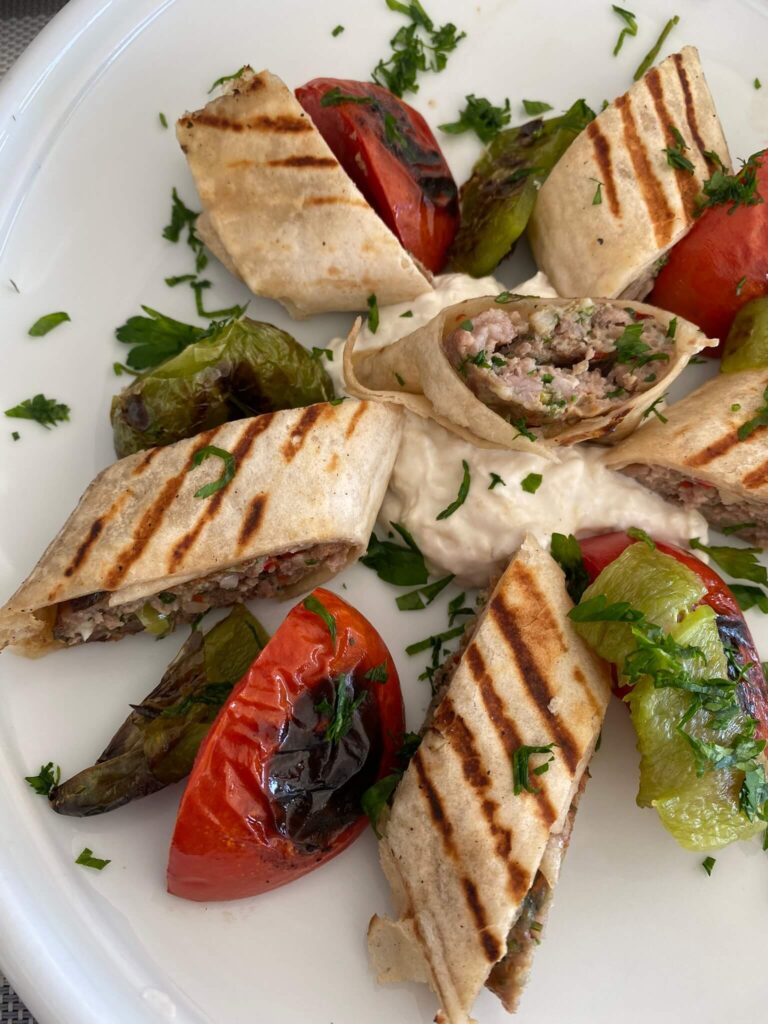
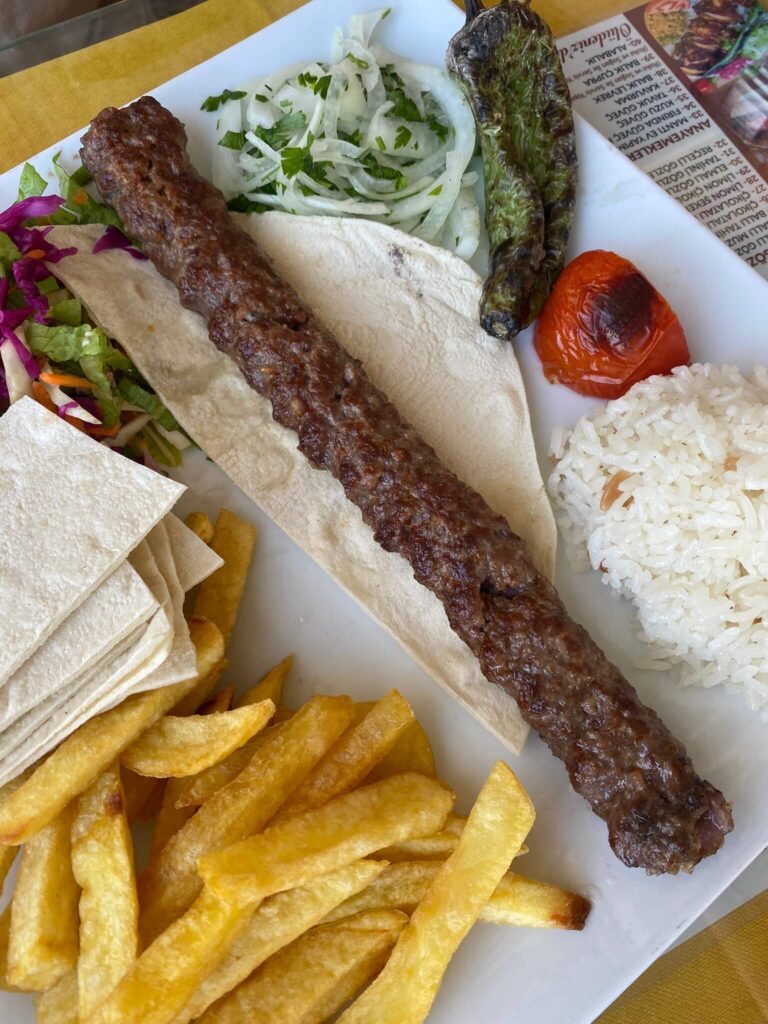
Lavash – Turkey food guide
Lavash is a flat, wheat bread that is served with many dishes in Turkey. Often, kebab is wrapped in a durum version of lavash. We guarantee that you won’t have to look far for it, and it will certainly make its way onto your plate.
Yogurt Soup (Yayla Çorbasi) – Turkey food guide
We had yogurt soup in Cappadocia, but we also saw it in other regions of the country, and it was difficult for us to determine where it originated from. The soup is aromatic and slightly acidic, served with rice. It sounds exotic, tastes great, and there’s nothing to be afraid of!
Turşu – Turkey food guide
A pickle side dish for dishes, very similar to our Polish ones, may be somewhat surprising. In Turkey, popular pickles include cucumbers, cabbage (although cut in a different way than ours), carrots, peppers, and many, many others.

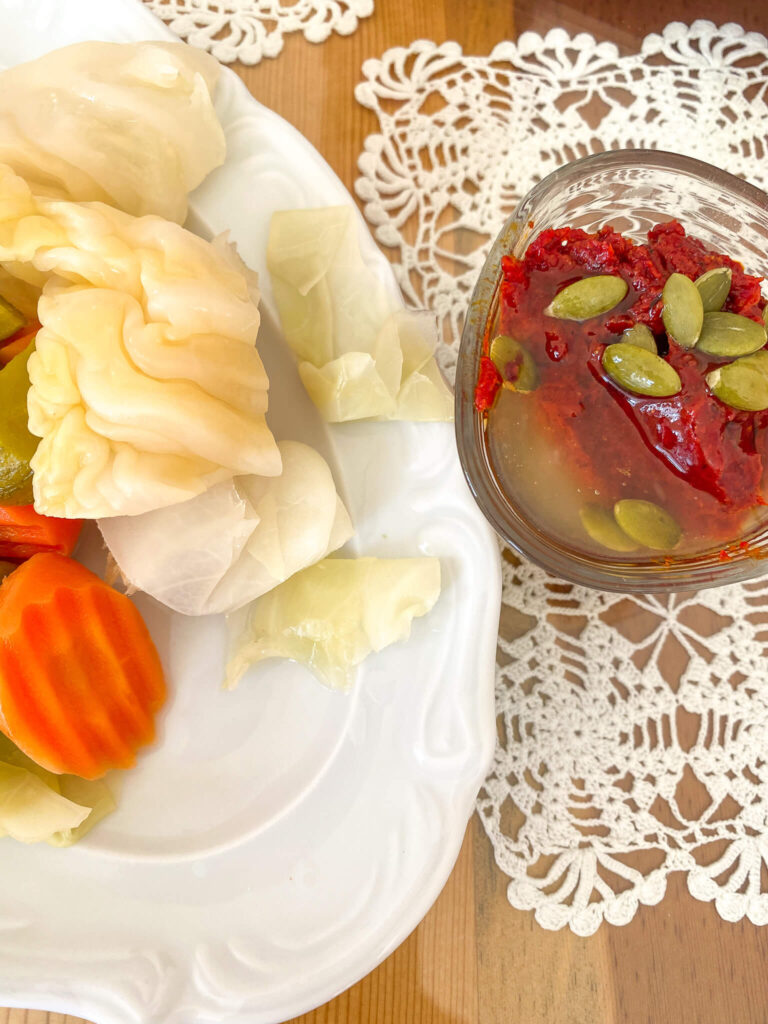
Kofte – Turkey food guide
Flat, meatballs made from lamb or beef with spices added. Served in the same way as all types of kebab. An interesting variety of meatballs is İçli Köfte, also known as Kibbeh. It is a bulgur wheat pastry filled with minced meat, which is formed into a characteristic elongated shape. We also had Kibbeh in a vegetarian version with mushrooms and nuts.
Pide – Turkey food guide
Pide, like the next item on the list, is often called Turkish pizza. It’s not quite pizza, but a tasty dish in itself and worth trying! Pide is a flat bread shaped like a boat, baked with various toppings on top, with ground meat and cheese being popular, and often topped with an egg.

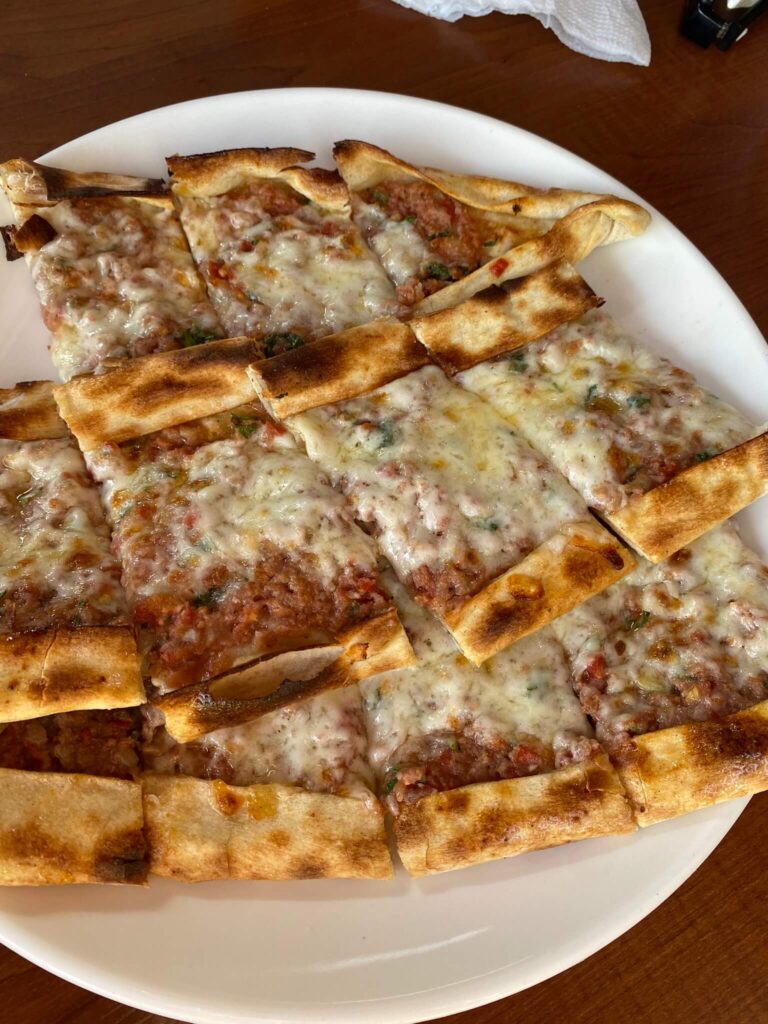
Lahmacun – Turkey food guide
Lahmacun is also a flatbread served with minced meat on top. It differs from its predecessor in that it has a smaller amount of meat, is round in shape, and has a thinner crust. However, the differences are really subtle.
Gozleme – Turkey food guide
Stuffed pancakes prepared on a heated pan (which looks like a huge upside-down pan) often in front of the guests. The toppings are added to the raw dough, folded in half, rolled out, and then fried with the filling already inside the dough. One of the more popular types is spinach and cheese, but everyone will find something for themselves! We also saw gozleme in a sweet version.
Ekli ekmek – Turkey food guide
Another version of Turkish “pizza,” ekli ekmek is a flatbread with minced meat that is well seasoned. Ekli ekmek usually has an oval shape and is sliced into strips before serving, just like pide. Restaurants serving ekli ekmek usually also have pide on their menu. It is said that ekli ekmek is simply one of the types of pide originating from the Konya region.
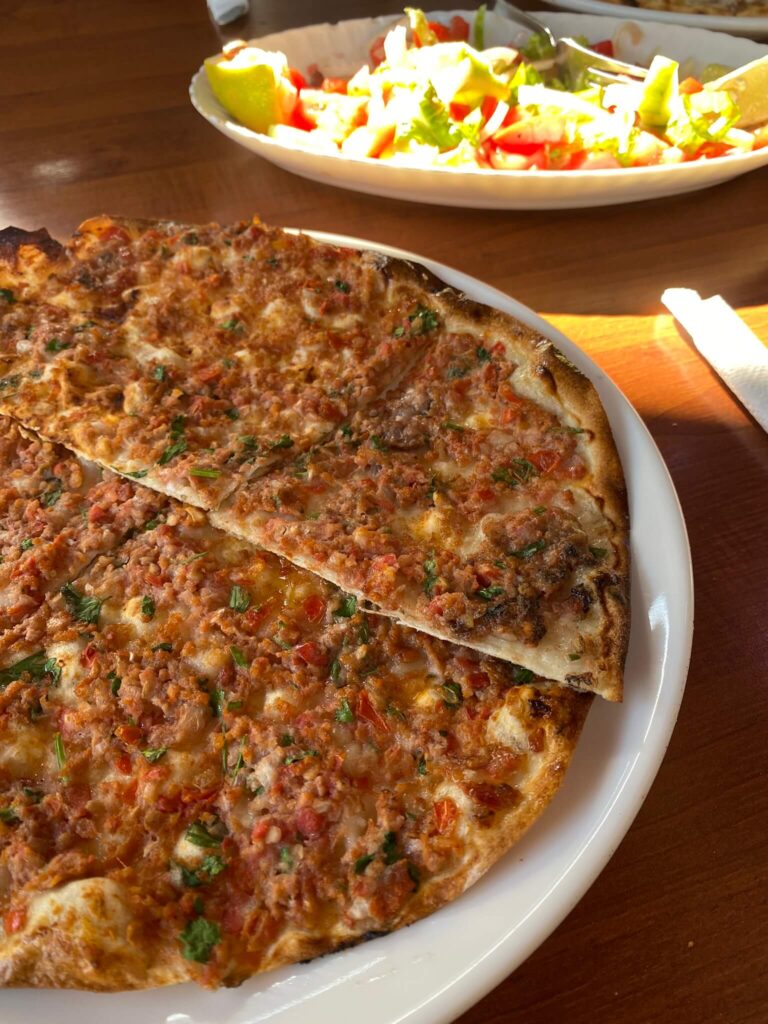
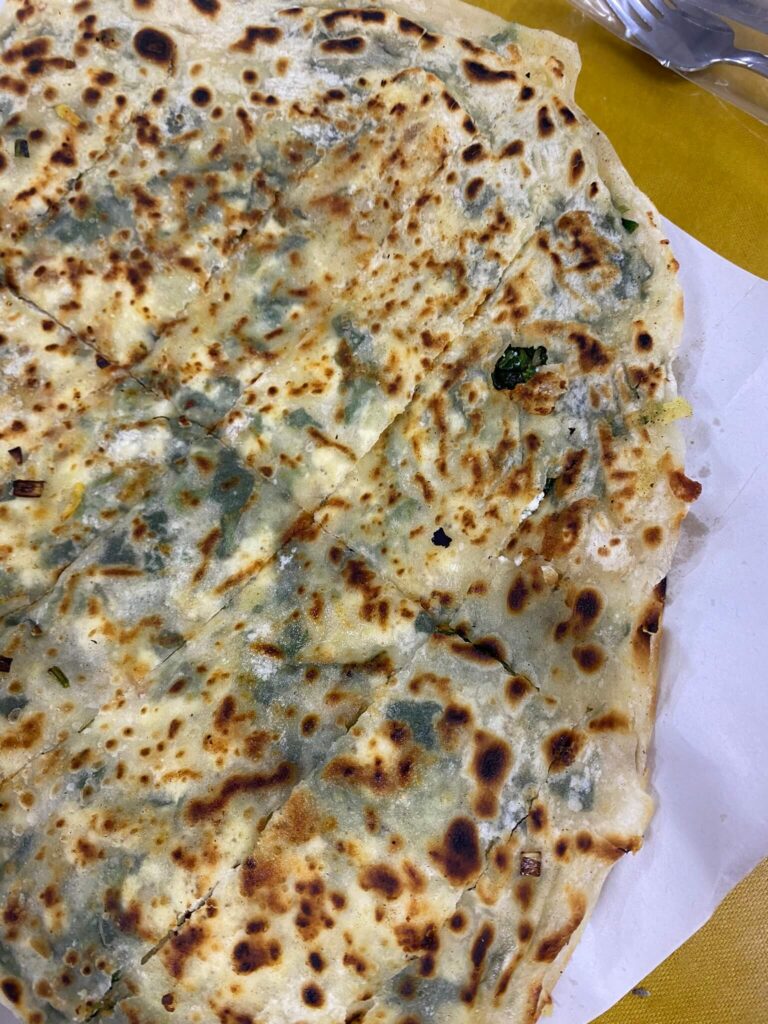
Cacik – Turkey food guide
The Turkish version of the dish known in our parts as Greek tzatziki. It is prepared with yogurt, grated or sliced cucumbers (we tried the sliced version), garlic, and olive oil, and often includes mint and dill as well.
Hummus – Turkey food guide
Hummus is one of those dishes that you can find in many Middle Eastern countries and is also popular in Turkey. The chickpea and tahini paste will taste slightly different in every place. Hummus is often part of Turkish meze, which are small plates of appetizers, among which pastes reign supreme.
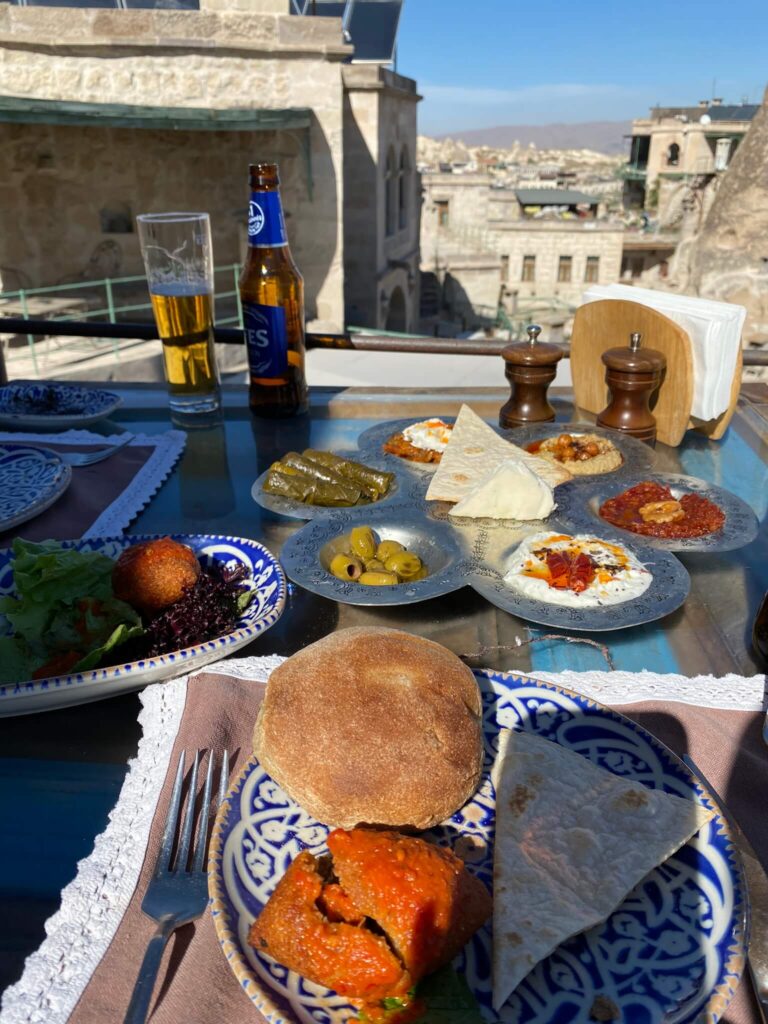
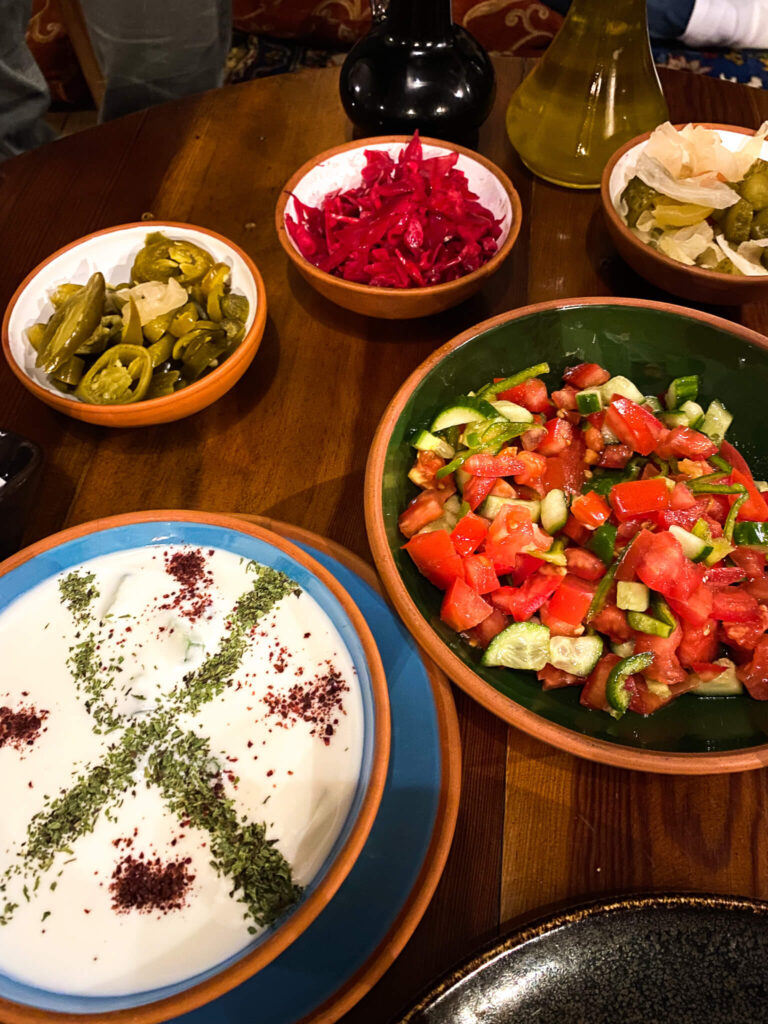
Kaymak – Turkey food guide
White, creamy cheese made from buffalo milk and cream. Often served as an accompaniment to meat dishes (with some types of kebab), also used for desserts.
Sarma and Dolma – Turkey food guide
The differences between some Turkish dishes are often so subtle that they are difficult to notice at first glance. Both sarma and dolma are something like stuffed cabbage rolls, but much smaller, and usually grape leaves are used (less commonly cabbage). Inside, you will most often find minced meat, but also often grains, wheat, and many other ingredients. The filling of sarma and dolma is usually highly seasoned and aromatic. Dolma means “stuffed” and sarma means “wrapped”. There is no major difference between these two dishes, but it is worth knowing that they may appear under different names.
Simit – Turkey food guide
Simit is a delicious Turkish bagel coated in sesame seeds. It accompanied us every day for breakfast and is a pastry that we miss terribly now!
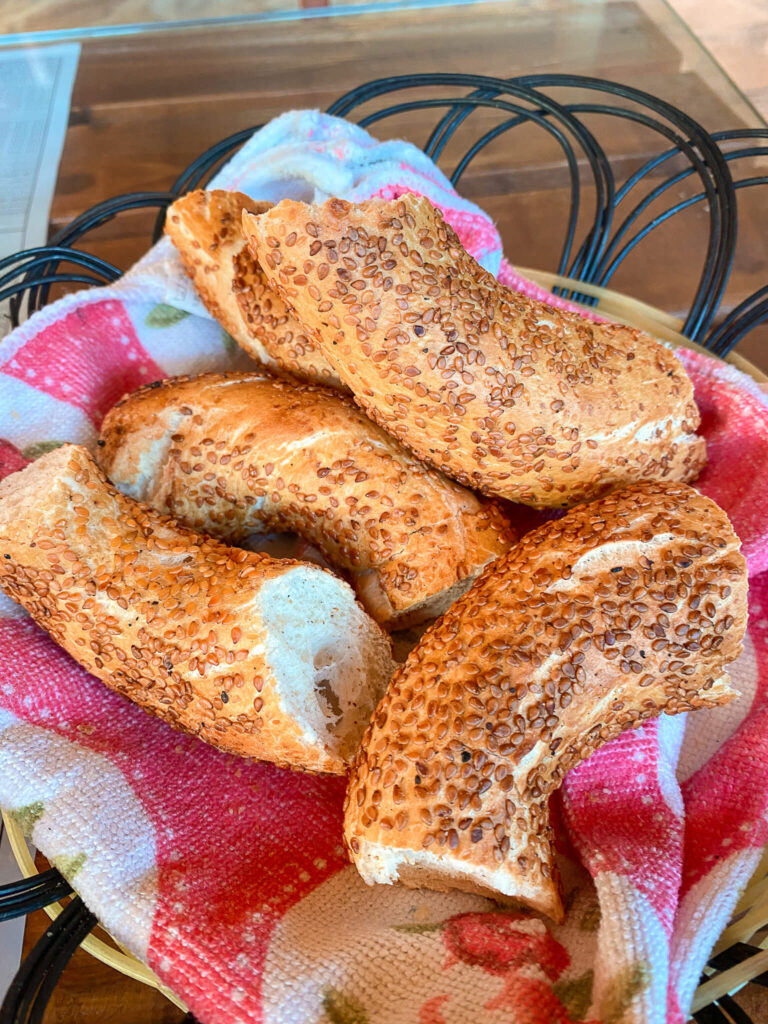
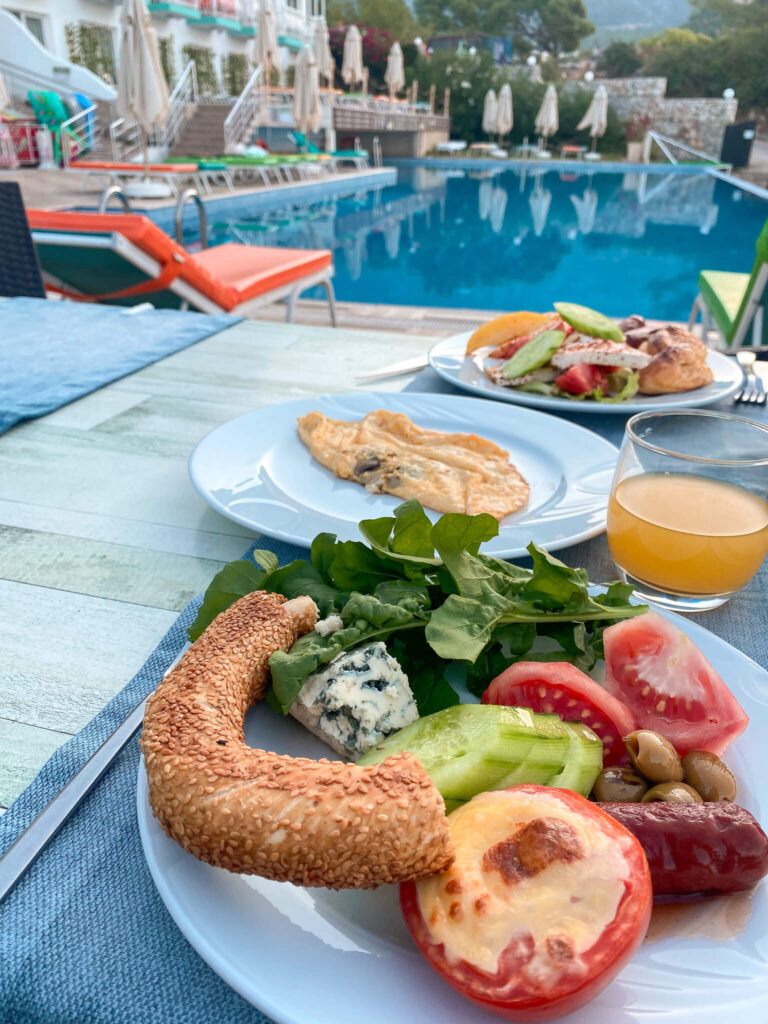
Menemen – Turkey food guide
Many people compare menemen to shakshuka, but in our opinion, it is simply scrambled eggs cooked with tomatoes, peppers, and spices. It is often one of the components of a Turkish breakfast.
Manti – Turkey food guide
Often called the “Turkish ravioli”. Manti are tiny, soft (they’re not usually cooked al dente) dumplings filled with meat and often served with tomato sauce and yogurt on top.
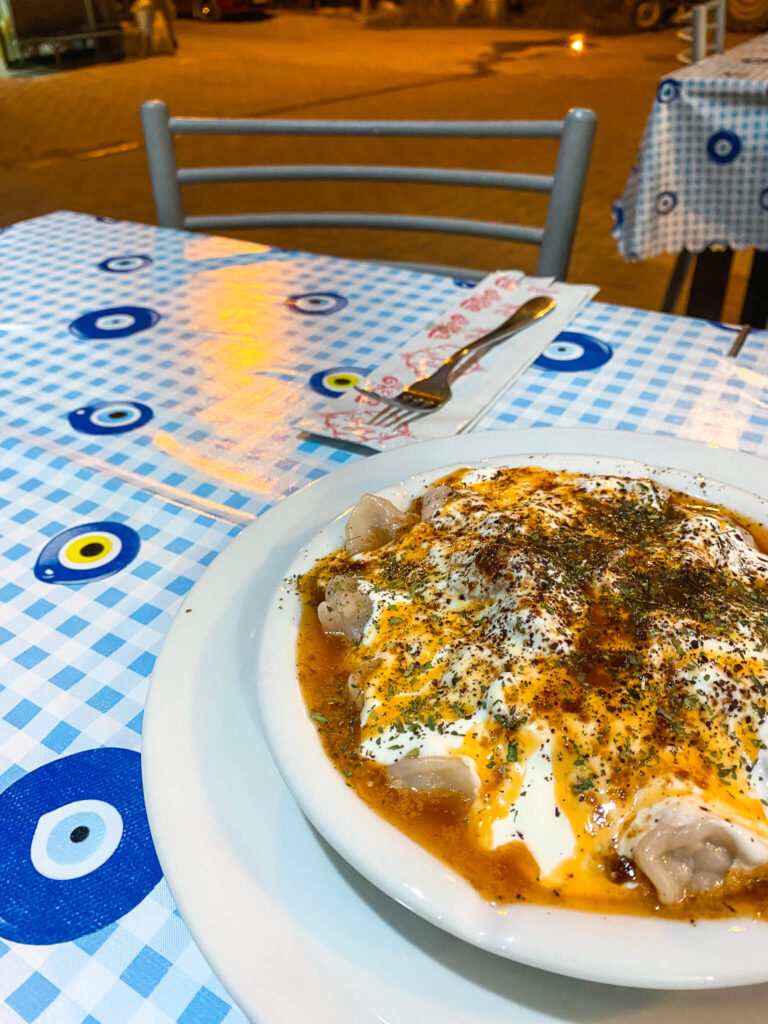
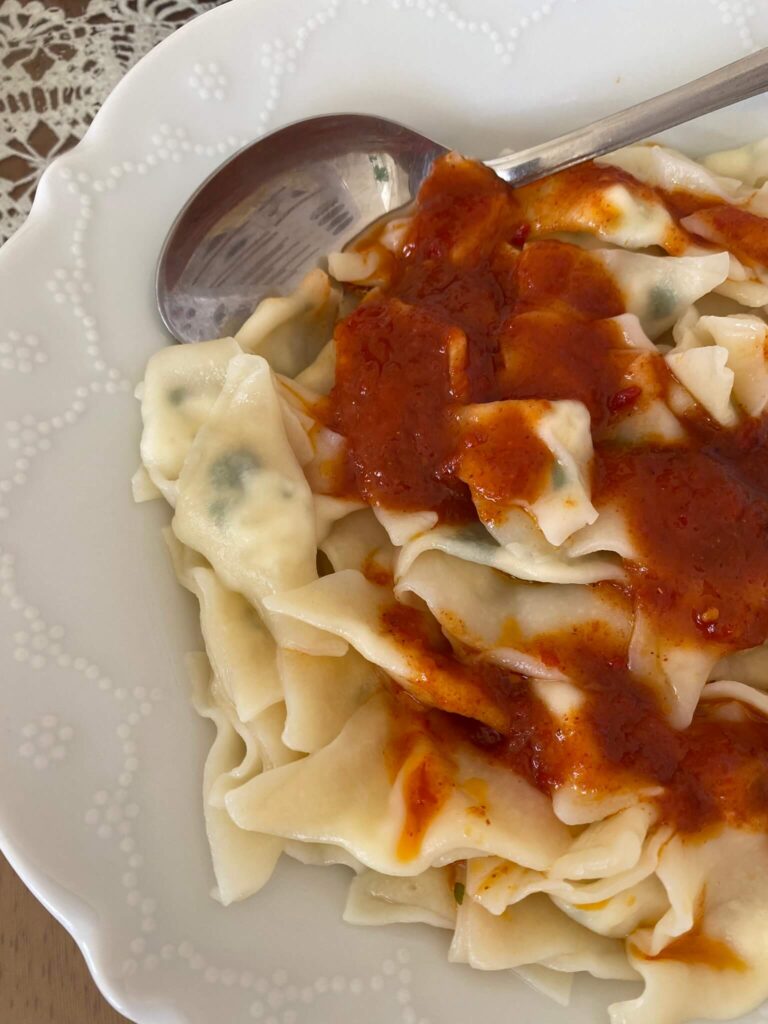
Borek – Turkey food guide
A pastry made with filo dough and filled with salty cheese or cheese and spinach, as well as many other fillings.
Ayran – Turkey food guide
A salty, diluted natural yogurt that can be found in both homemade and store-bought versions, similar to our kefir. Often drunk with lunch or dinner, especially if the dish is spicy. Apparently, people either love it or hate it, but we liked it and we’re not sure what’s so controversial about it.
Atom – Turkey food guide
A dip made with yogurt, dried cayenne pepper, garlic, and butter, often drizzled with olive oil.
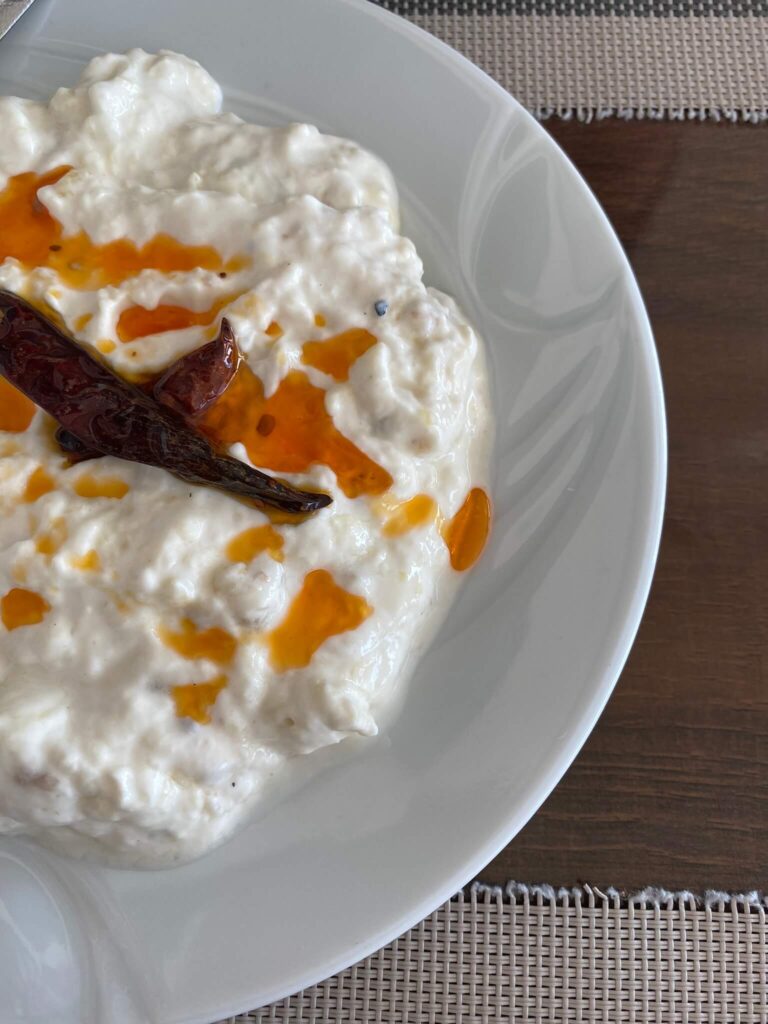
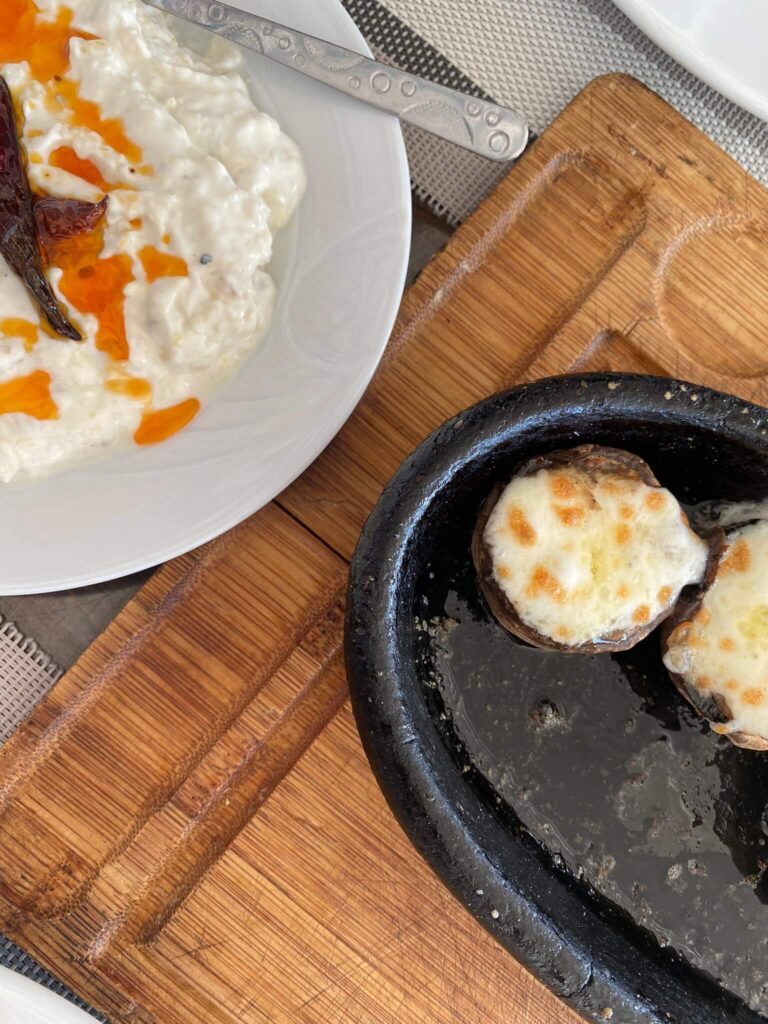
Baklava – Turkey food guide
Baklava is one of our favorite Turkish desserts, made of flaky filo pastry layered with honey and nut filling. There are countless versions of baklava, all equally sweet and delicious. It’s served in small pieces, because you really don’t need much to satisfy your sweet tooth. We love the pistachio version the most, but it’s worth trying a few different ones to find your favorite.
Kunafa – Turkey food guide
Kunafa is definitely the strangest, but very tasty Turkish dessert. It’s made with shredded kadayif pastry filled with unsalted cheese and drizzled with attar, a sweet syrup. Kunafa is sprinkled with crushed pistachios. The baked threads are crispy, the cheese is stretchy, and it’s all extremely sweet – we recommend ordering a half portion!
Lokum (Turkish delight) – Turkey food guide
Although Turkish cuisine is generally quite healthy, it’s hard to resist their sweets and they will ruin any attempts to maintain a good figure on vacation… Lokum, also known as ‘Turkish delight’, comes in many different versions, some of which can be described as similar to jelly. Lokum is often sugar-coated pieces of jelly or whole rolls made of hard fruit jelly (often rose-flavored), various types of nuts, rose petals, or nougat, which are sliced into pieces. A million calories, but no regrets!
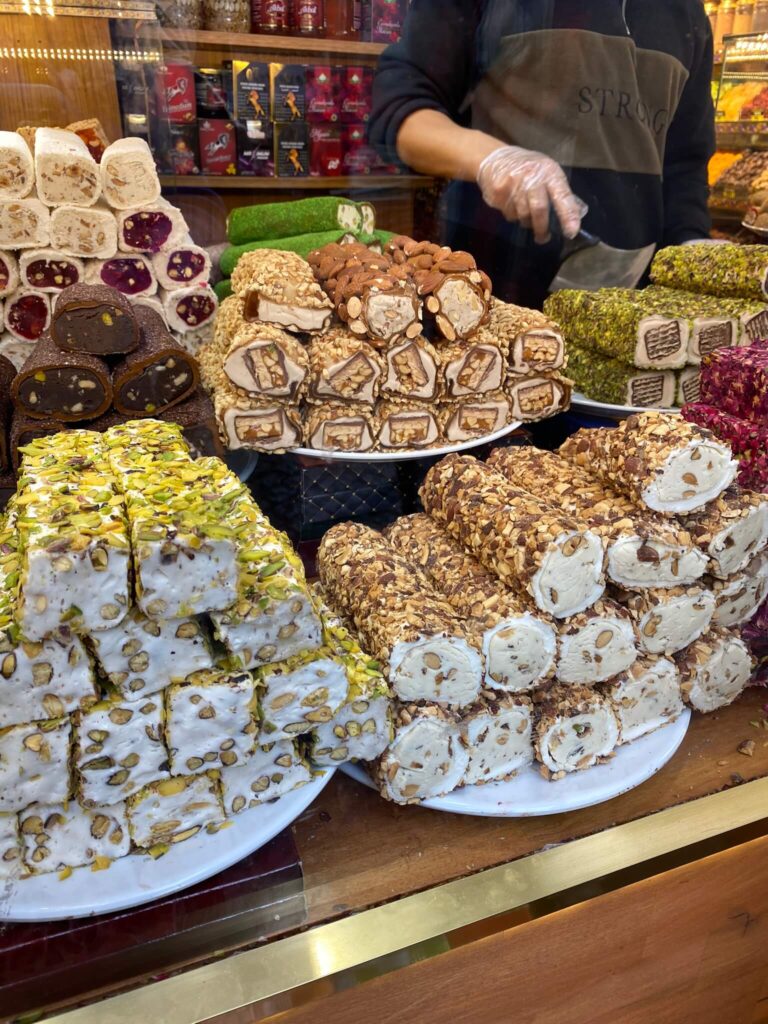
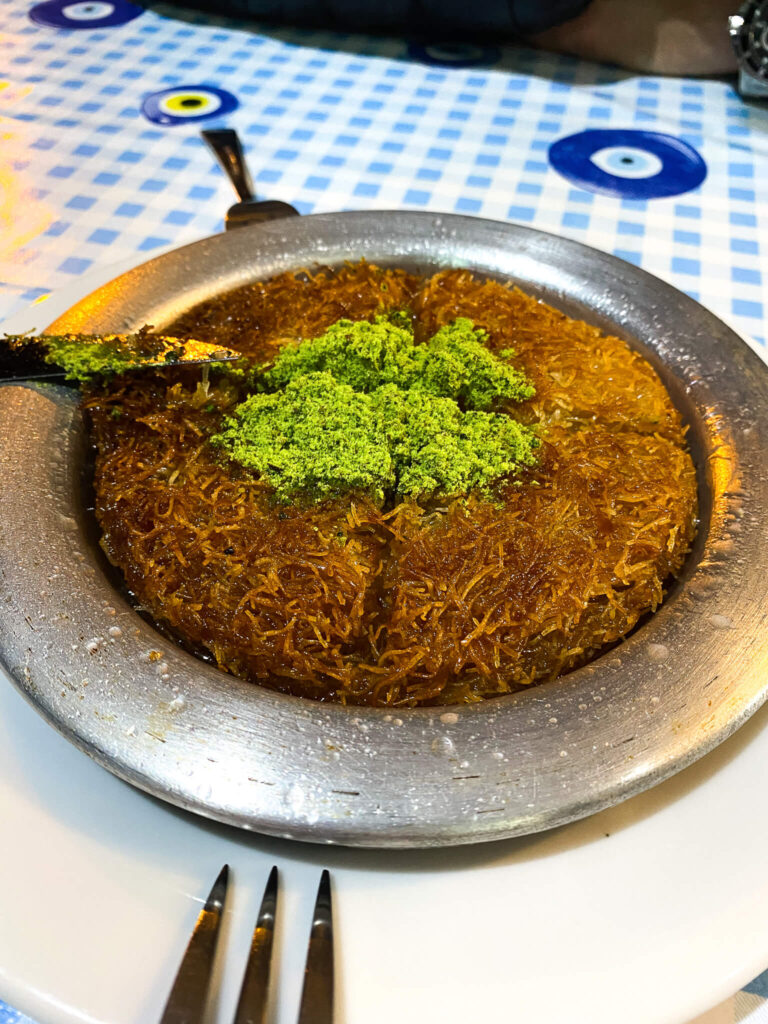
Trileçe – Turkey food guide
Trileçe is a dessert originating from the Balkans, but also popular in Turkey. It’s no wonder that Turkish cuisine is influenced by the cuisine of many other countries, as the Balkans and many other regions belonged to the Ottoman Empire, and cultures and their cuisines mingled. Trileçe is a delicate sponge cake soaked in three kinds of milk: cow’s, goat’s, and buffalo’s, often covered in a light caramel sauce. Compared to other Turkish desserts, which are extremely fatty and sweet, Trileçe is a refreshing and simple concept – but simplicity is its strength!
Dondurma – Turkey food guide
Dondurma is a Turkish ice cream, but it is drastically different from Italian gelato or scoop ice cream known in other parts of Europe. Dondurma is made with salep (powdered orchid bulbs) and mastic, which give the ice cream a strange, chewy texture and also make it melt much more slowly.
You’ll see many dondurma carts with traditionally dressed men serving them – in such cases, you’ll get a tourist performance along with your ice cream. The man will do various tricks, leaving you with just the cone without the ice cream, tricks possible only because of the unique texture of dondurma. This is not a traditional way of serving, fortunately in non-touristy places, we were served ice cream in a normal way.
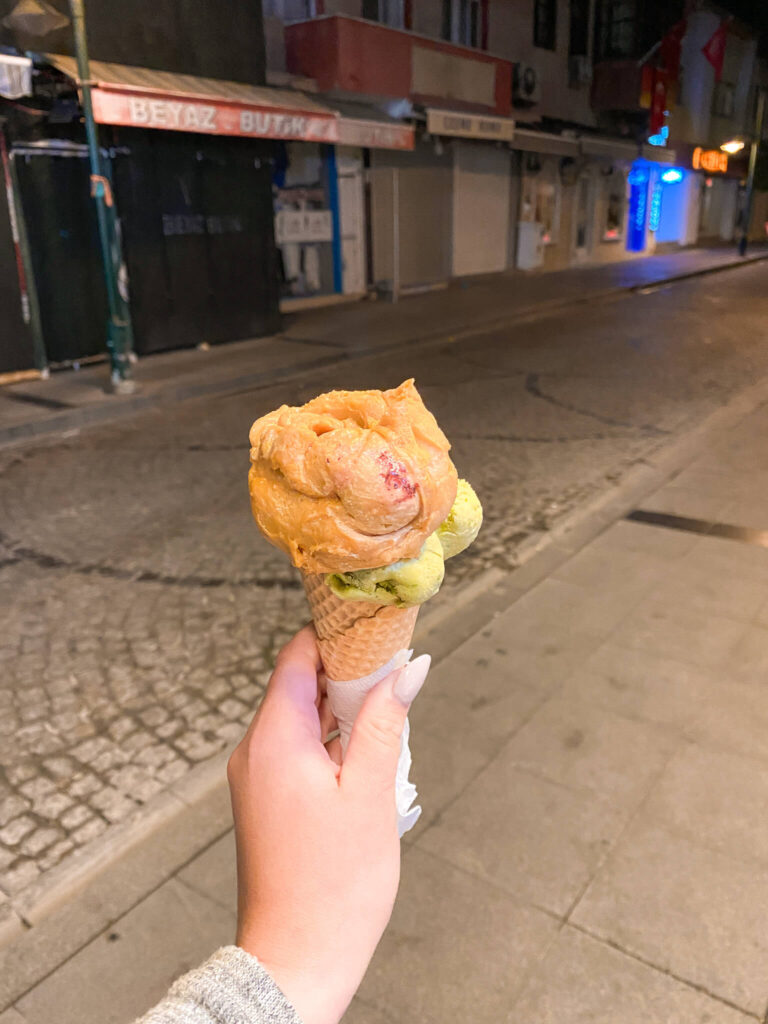

Halva – Turkey food guide
In Turkey, you can find two types of halva. The more well-known sesame halva, a block made of ground sesame and sugar, which is created in many flavor variations, is only one option and is less common in Turkey than the second one. Halva number two is made with semolina, sugar, fat, and milk, and is often served with ice cream.
Turkish coffee – Turkey food guide
Made from ground coffee beans, Turkish coffee is boiled in a small, distinctive pot. It is usually served with sugar in a small cup, and in some places, you can find different variations of it, such as pistachio coffee.
Turkish tea – Turkey food guide
Strong, sweet, black tea, which is served in small, distinctive glasses, is an integral part of almost every meal! Tea is drunk by the liter, and it is often served for free.
Pomegranate juice – Turkey food guide
Fresh pomegranate juice sold in many street stalls is a taste of Turkey that you must try. It’s slightly sour, slightly bitter, and absolutely delicious! If you don’t like bitterness, you can try the version mixed with citrus fruits.
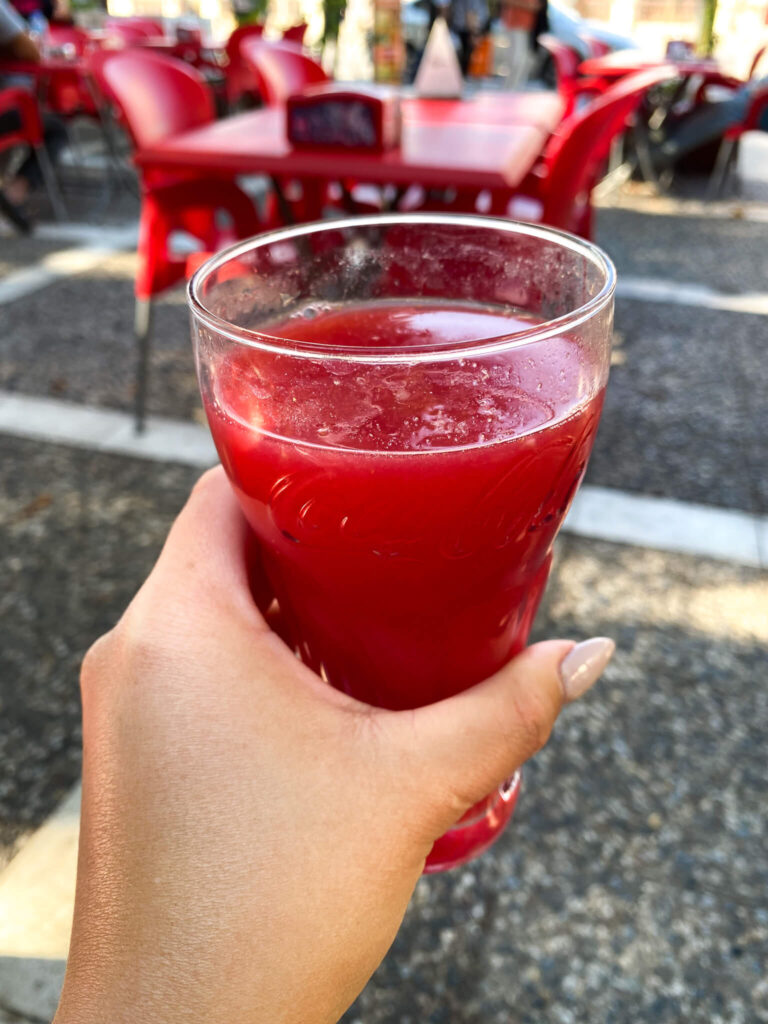
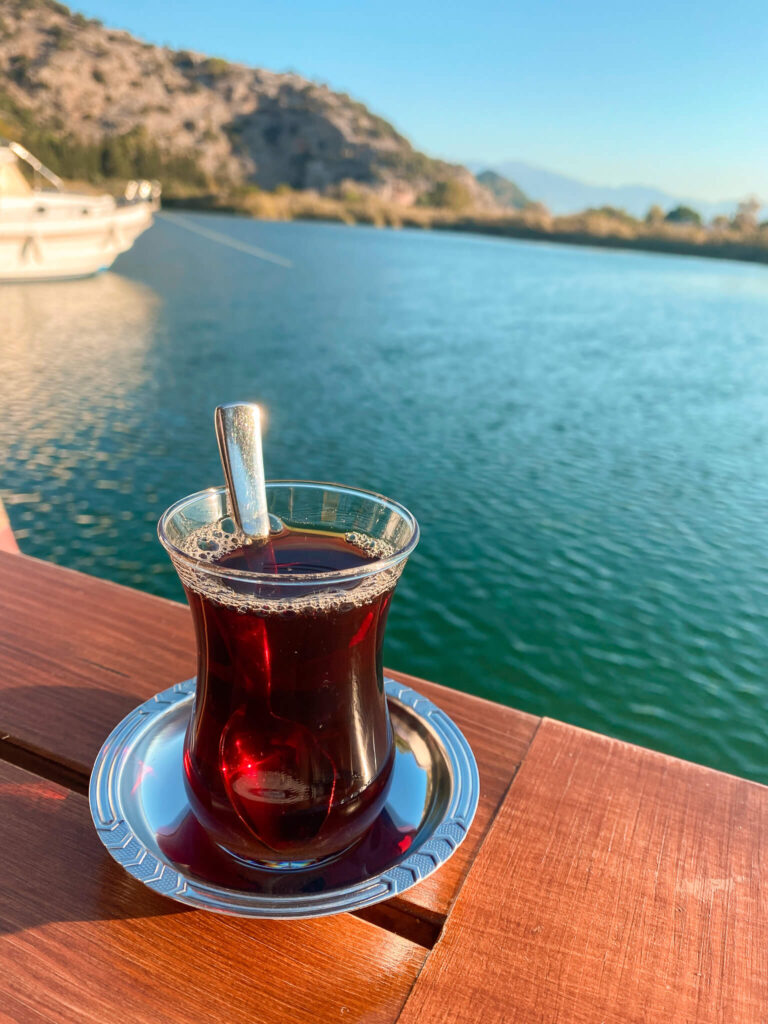
Turkish breakfast – Turkey food guide
Turkish breakfast is a real feast, even the hotel breakfast (it was hard to find a hotel without breakfast) was amazing. Turkish breakfast usually consists of several small bowls and plates of various delicacies. There are baked goods from bread to simit, various types of olives, fresh vegetables and cheeses (rarely cold cuts), menemen, often fried eggs (we couldn’t find Turkish-style eggs anywhere), as well as jams and fresh fruits. A poetry for breakfast lovers!

What and where to eat in Turkey? – Cappadocia
Doing research in a country that is known for mass tourism, but still has a lot to offer locally, it’s often hard to find information about the origin of certain dishes (especially since not everything about Turkey can be found in English). We wanted to note that we’re not sure if the following dishes come from Cappadocia, but it was easiest to find them on the menu there.
Testi kebap (pottery kebab) – Turkey food guide
Kebab prepared in the form of a stew baked in a special clay pot, which takes several hours to prepare. It’s available in chicken (tavuk), lamb or beef (et – it’s worth asking what specific “et” is used in a particular place). Pottery kebab in Cappadocia is a bit of a performance because tourists are usually served with a flaming pot that is opened in front of them. In the best restaurants that prepare it fresh (and not reheat like most), you should order it at least 4 hours before your planned visit.
Aside – Turkey food guide
A strange dessert made of flour, water, and molasses, slowly cooked in a pot. We ate it with ice cream, it was interesting, but we didn’t love it.
Ayva dolma – Turkey food guide
This dish supposedly originates from Cappadocia, but we happened to try it in Istanbul. It is a stuffed quince with meat, which is not minced but rather “pulled”, and we tried the beef version. The meat is heavily spiced and cinnamon is distinctly noticeable.
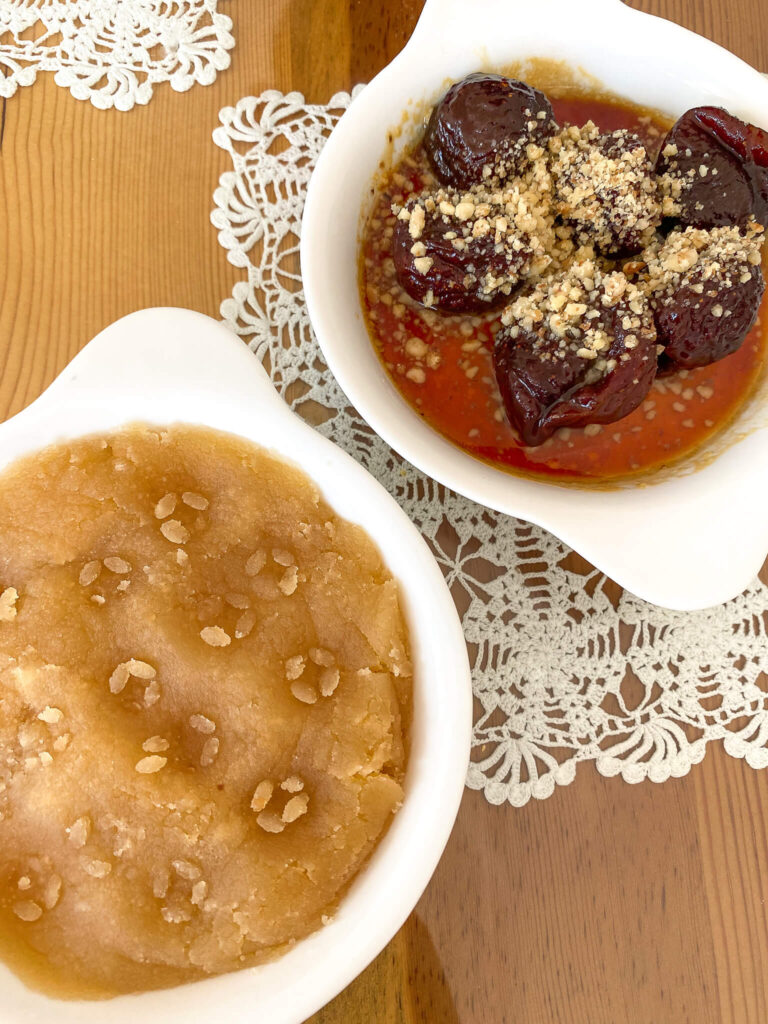
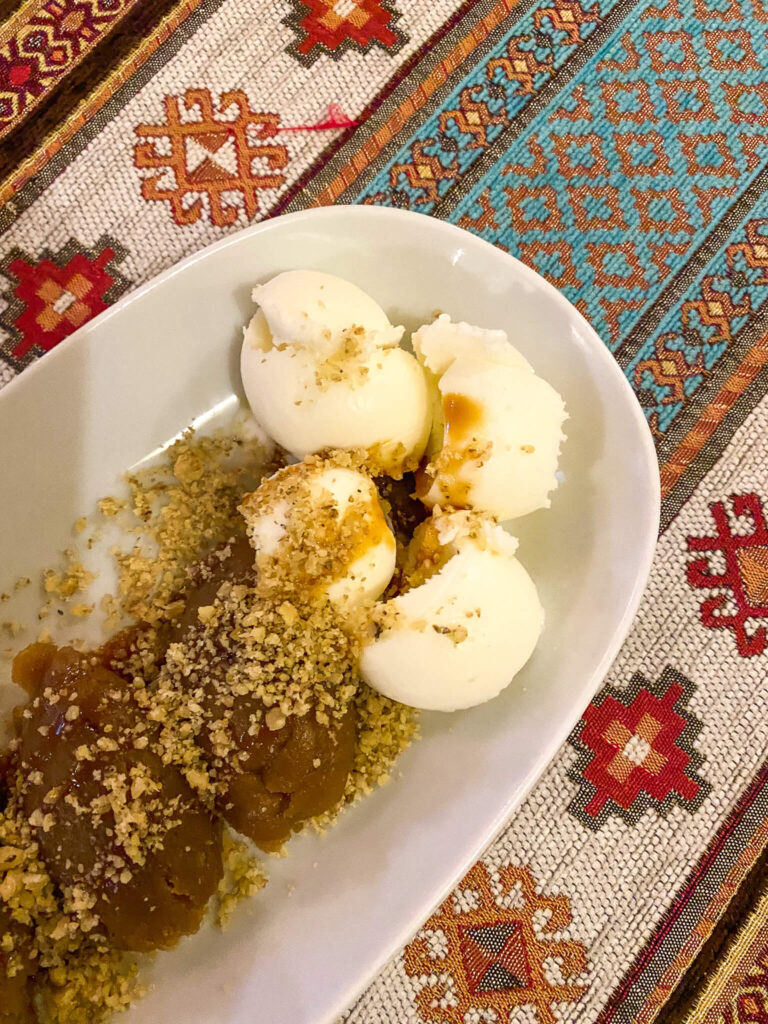
Wine – Turkey food guide
Unfortunately, growing grapes and producing wine is not the easiest business in Turkey, but it is a shame because grapes actually come from the Turkish lands and the oldest grape varieties can be found there. Turkey produces truly wonderful wines, although not very well known in Europe, and it may not be on par with France or Italy, but there really is nothing to complain about! Cappadocia is one of several wine regions, and while you’re there, you must try the Kalecik Karasi (red), Okuzgozu (red), Bogazkere (red) and Emir (white) varieties.
What and where to eat in Turkey? – Istanbul
Kestane kebap and Mısır kebap – Turkey food guide
Usually sold from a single cart – roasted chestnuts and corn are classics that you will encounter in many places in Istanbul.
Kokorec – Turkey food guide
Kokorec is various types of ground offal wrapped in lamb intestines and horizontally roasted. Served in a sandwich (ekmek) with chopped peppers. We expected extreme sensations, which weren’t quite as extreme, and the sandwich went down the throat even for Aneta, who doesn’t eat offal.
Midye dolma – Turkey food guide
Stuffed mussels with rice, sold individually on the streets of Istanbul, but also found in other parts of the country. Although we love mussels, we were not impressed with this version.

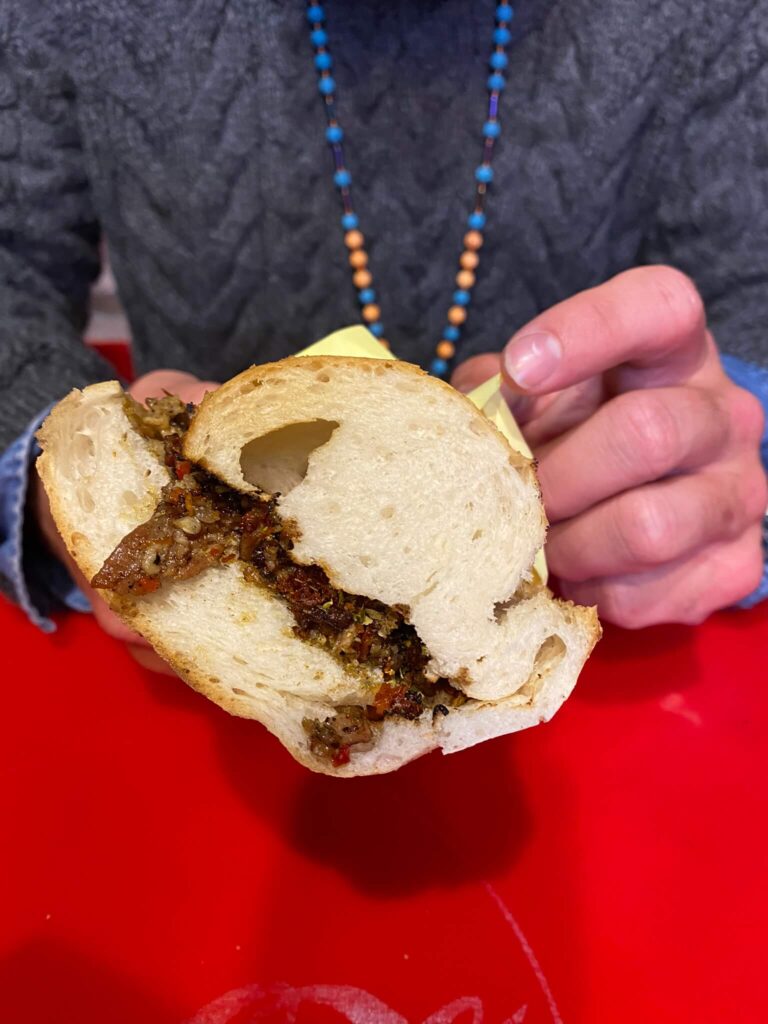
Balik kebab – Turkey food guide
Roasted fish (probably mackerel) served in the ekmek version, which is in bread, or in the durum version, which is in the form of a wrap. A specialty of Istanbul sold in many restaurants and stalls.
Lokma – Turkey food guide
Small, sweet donuts without filling, often sold in street stalls and drizzled with sweet syrup.
Kumpir – Turkey food guide
Baked potato mixed with butter and cheese and topped with a variety of toppings. Customers can choose their own toppings from a wide selection, including cucumbers, jalapenos, cabbage, olives, corn, various sauces, and more!
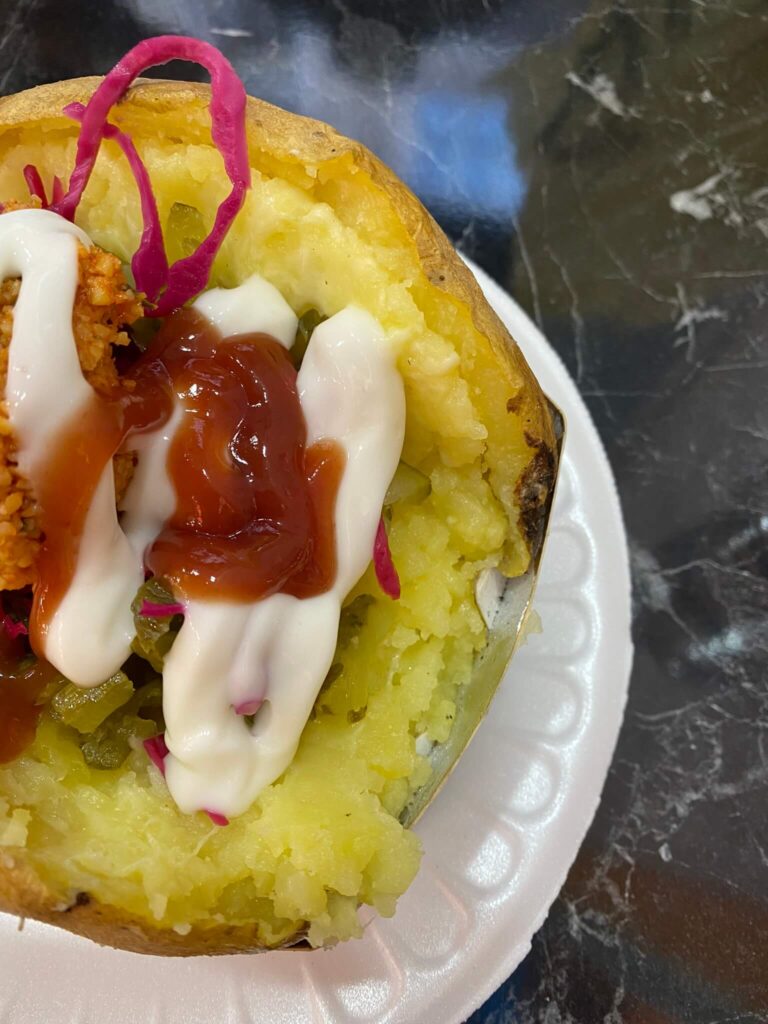
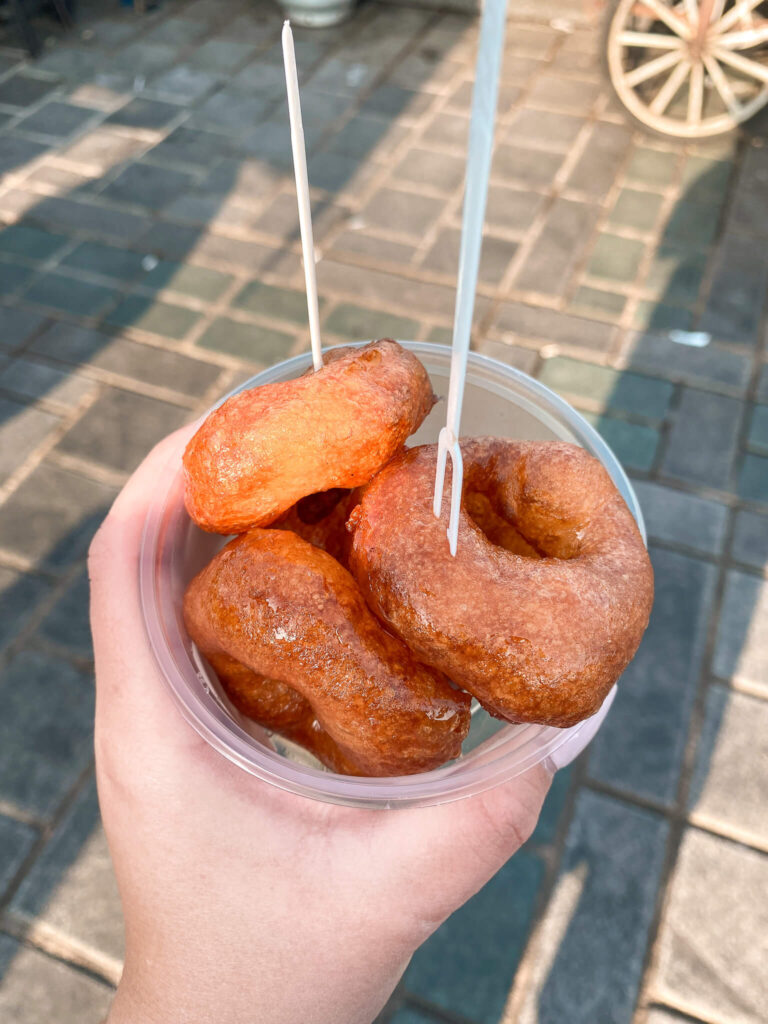
What and where to eat in Turkey? – Cesme
Bomba – Turkey food guide
A small pastry filled with delicious chocolate cream, best served fresh and warm. It probably comes in other flavors as well, but for us, chocolate is the winner.
Boyoz – Turkey food guide
Round buns made from layered dough in the French style, prepared more savory than sweet. They don’t have a spectacular flavor on their own, but as a base for a sandwich, they are probably delicious.
Cesme kumru – Turkey food guide
A sandwich originating from the Cesme area, consisting of a bun, grilled cheese, sucuk (a very specific Turkish ‘pepperoni’), tomatoes, sauce, and often an additional type of meat. Surprisingly, despite the presence of sucuk, the sandwich is really tasty!
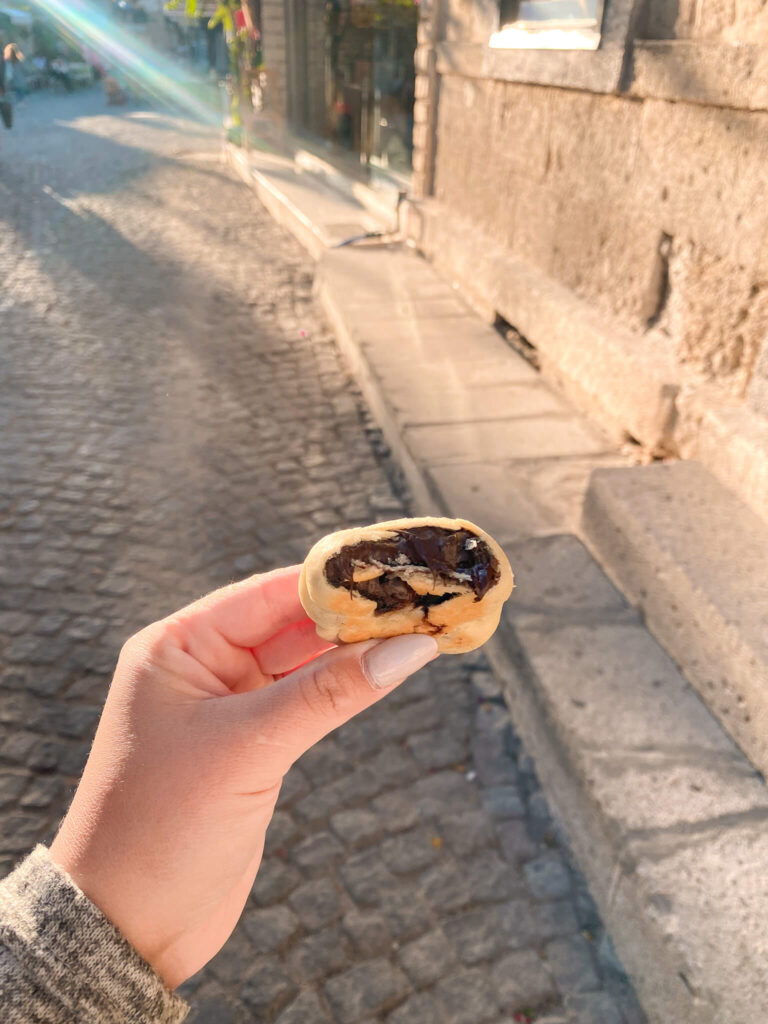
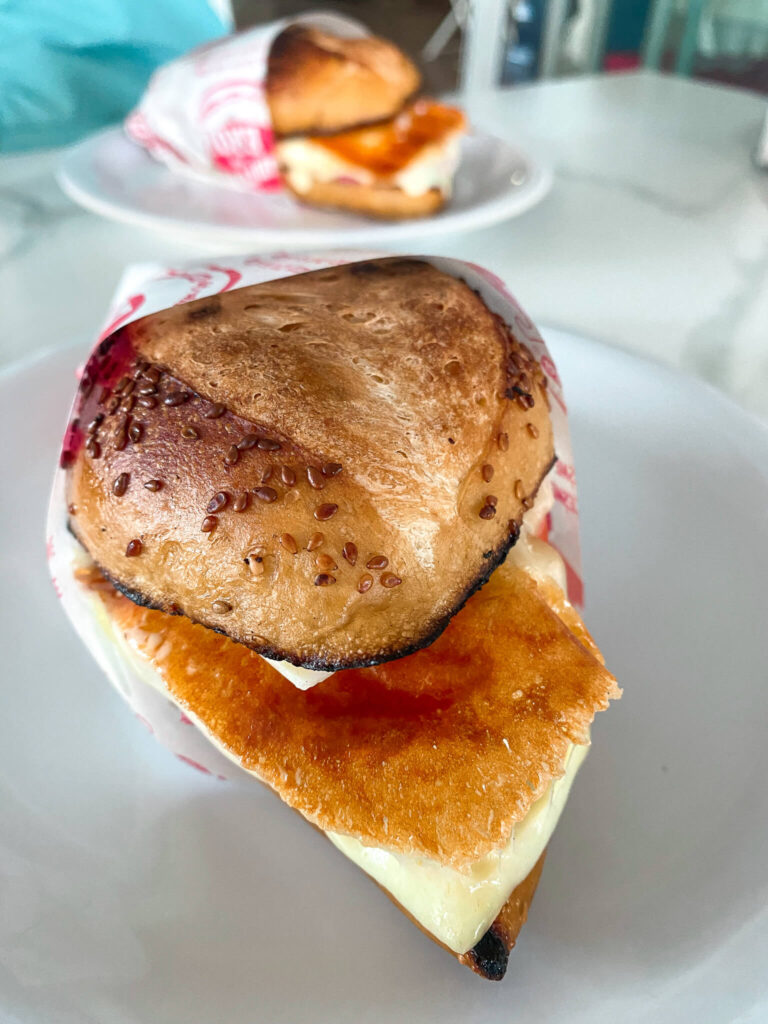
Where to eat in Turkey?
Cappadocia – Turkey food guide
Chef Kebap – a simple and affordable kebab restaurant in Goreme. The food was delicious, and we even got a free dessert, meze, and liters of tea. If you want to taste different types of kebab, this is a great place to go.
Dibek – one of the most recommended places for pottery kebab. You need to order it at least 4 hours in advance. The kebab was very tasty, but the place is not the cheapest.
Seten – the food was good, but it didn’t blow us away. The prices are high, and the portions (for Turkey) are rather small, but Seten boasts one of the best panoramic terraces in Goreme, so it’s worth going for a drink at least.
TIK TIK Kadın Emeği – a milk bar-style place run by older ladies with only a few tables inside. The ladies make handmade pasta, and you can watch their production while enjoying their meals because the pasta is also sold in packages here. Prices are low, and the food is sincere and incredibly delicious! In addition, the ladies cook a few dishes characteristic of Urgup and a few better-known ones in Cappadocia.
Lavanta Panorama Cafe – a cafe with a wonderful view of Ortahisar. They serve delicious pistachio coffee, and we also tried the nutty coffee, which was tasty but not as good as the pistachio one.
Topdeck Cave – a small restaurant where you can sit at a regular table or a traditional table on the floor, which is a great option if you plan to eat a lot. Their specialties are cold meze platters with various appetizers and cold pastes – simple and delicious!
Kocabag wines – Cappadocia is famous for its wines, and we highly recommend the Kocabag winery store, where you can try the wines before buying.
Turasan – the largest wine producer in the region. The prices in their shop are very favorable, but unfortunately, they do not do tastings here – apparently, it is possible to participate in a tour and wine tasting, but it is an activity for groups.
Istanbul? – Turkey food guide
Aheste – a restaurant that was awarded the Bib Gourmand distinction by the Michelin guide (which in 2022 gave the first star in history to Turkey!), which indicates a good value for money. Turkish food in the form of tapas or, in Turkish, meze, small plates of delicious food inspired by Turkey and local ingredients, but with an interesting twist. After the tasting menu, we were really full, and a few dishes really impressed us! Aheste was a nice surprise after visiting another Michelin place that left us a little disappointed…
Neolokal – a restaurant that was one of the first in Turkey to receive a Michelin star. The food was tasty and correct, the ingredients excellent, and everything inspired by Turkish cuisine, but it simply lacked that extra something. We left slightly hungry, although we rarely do after a set menu, but the place did not wow us as we expected. Looks like celebrity-chef is the reason for the star, not extraordinary food itself. We’re not saying the food was bad, but for a star, it was a little lacking, and in our opinion, Aheste beats this place hands down! The wine pairings were also disappointing, with micro-portions of wine.
Seven Hills – we can’t vouch for the food, but it’s hard to beat the view of Hagia Sophia and the Blue Mosque! The restaurant is located on the roof, and the views are truly magnificent. Unfortunately, a silly habit has been introduced there of feeding seagulls fries for a photo, so crowds pass through the roof and gulls hover over their heads… The feeding zone is marked off, but it’s still crowded, and we don’t approve of feeding animals…
Çiya Sofrası – a restaurant in the Kadikoy district in buffet form, where we choose most dishes, including the salad bar, at the counter. You can try many interesting Anatolian dishes.
Eywa Sebastian – thanks to a popular cheesecake chain, Basque cheesecake is breaking records in Istanbul. It wasn’t our thing, so we ended up in this place in the trendy Moda district. The cheesecake was delicious and melted in our mouths, and they also have tasty coffee if you feel like a latte or cappuccino.
Comedus – a wine shop where you can have a glass of wine and indulge in a cheese or charcuterie board. A very atmospheric place in the Pera district.

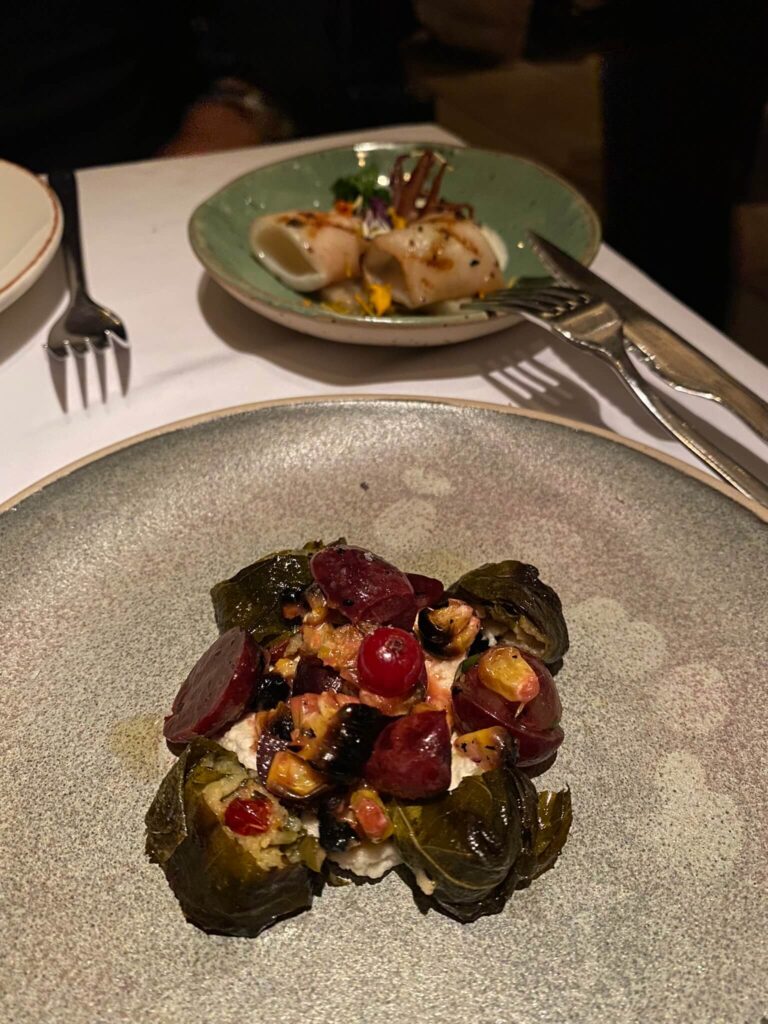
Cesme and Ephesus – Turkey food guide
Selcuk Pidecisi – a simple but popular eatery in Ephesus that mainly serves pide, which is a kind of “Turkish pizza,” cheap and very tasty!
Çeşme Balıkçısı Tektekçii Meyhanesi – a restaurant on the seaside promenade, we opted for seafood, which was delicious, but the portions were rather small. As we noticed, a better choice would have been meze, a very popular option in this place was also Turkish raki, which we honestly don’t like.
Rumeli Pastanesi – if you want to try really great ice cream dondurma and you’re not necessarily in the mood for this tourist show, you’ll be satisfied! While the taste and aroma of ice cream in this place are brilliant, the dondurma ice cream texture is not totally appealing to us.
Kumrucu Kale – a bakery that sells amazing, warm bombs, which are cookies with chocolate filling!
Pamukkale – Turkey food guide
As Teras Mantı Evi – a small family-run restaurant where we were surprised to see the use of a microwave. Despite our concerns about this, the food was delicious, homemade, and cheap, and the portions were really big! We tried kunefe there and highly recommend it!
Dalyan and Oludeniz – Turkey food guide
Gözlemeci Sema & Ev Yemekleri – a small family-run place in the tourist area of Oludeniz. Tasty and relatively cheap, but the portions are not that big there.
Gözde Restaurant – good prices and giant portions, we ate there several times because we loved it so much. Located in the less touristy part of Oludeniz, the restaurant was filled to the brim with locals every day. Great kebabs, amazing grilled chicken wings (without unnecessary sauces and additives), delicious gozleme pancakes.
Agora Restaurant – a place we stumbled upon on the way from Oludeniz to Dalyan, when we arrived in the middle of the day and it was empty, which worried us a bit, but unnecessarily. We tried the Sarma kebab there and it was one of the best-seasoned and tastiest kebabs we had in Turkey!
Ekin Kır Evi Restoran – Dalyan itself, although rather non-touristy, surprised us with high prices. We managed to find this place while camping and both the prices were reasonable, the portions were big, and the food was fresh and tasty. We tried grilled fish and both of the ones we ordered were excellent!
